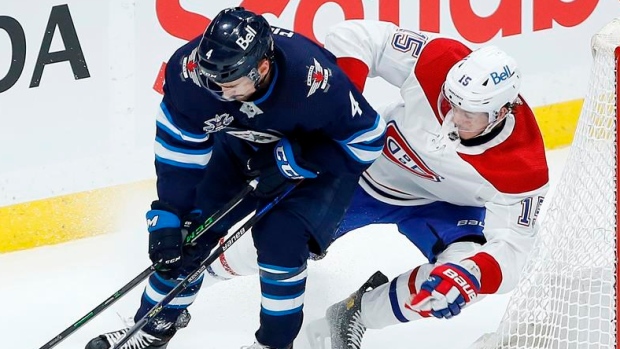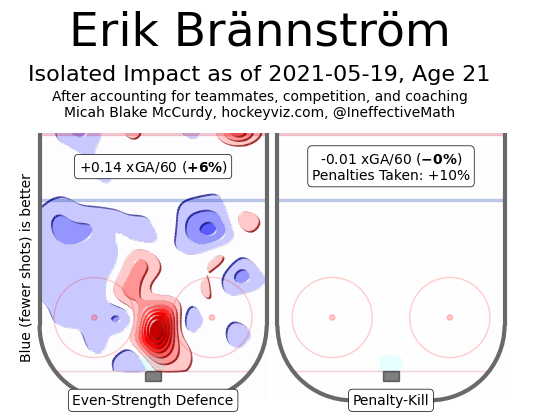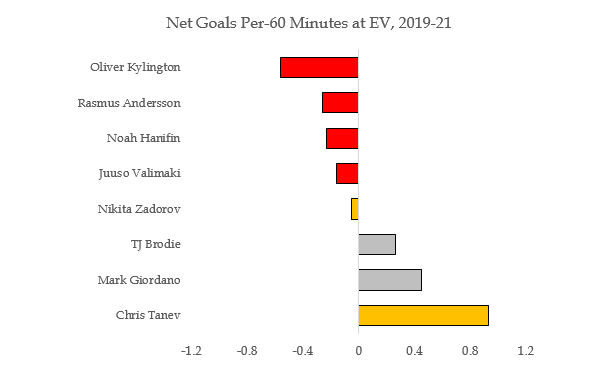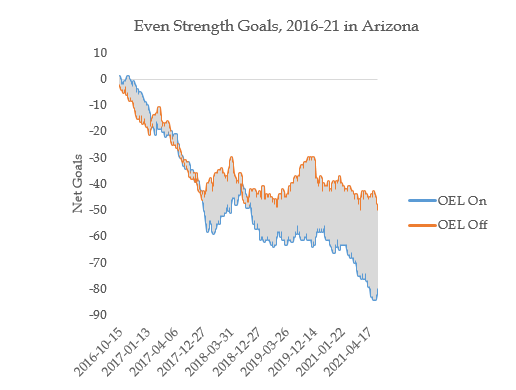Sep 9, 2021
Grading the defencemen on Canada's NHL teams
On Tuesday, Travis Yost began a position-by-position preview of the seven Canadian clubs, grading out the centre position for every team. Today, he focuses on the defencemen.
By Travis Yost

On Tuesday, we began a position-by-position preview of the seven Canadian clubs, grading out the centre position for every team. Today, we will focus on the defencemen.
Let’s start with our player table. For the focus group here, I grabbed an expected top six for each team, though competition for a number of third-pairing spots will exist in most markets.
Here is how each team stacks up against one another:

And now, for grades.
Toronto Maple Leafs (A-)
For years, Canadian teams struggled to build credibility on the blueline, and the Maple Leafs were at the top of that list. It wasn’t long ago you would look at Toronto’s defensive options and shudder in fear.
But times have changed. The organization has invested aggressively at the position, acquiring veterans – and more importantly, gifted two-way players – Jake Muzzin and T.J. Brodie over the past two years. Add homegrown talent Morgan Rielly and that’s as strong a top three as you will find in the National Hockey League.
The Maple Leafs have also done tidy work bolstering depth at the position through more internal development. Travis Dermott is a talented puck mover who can pick up spot power-play minutes. Rasmus Sandin has shown to be a brilliant decision maker who can offset a lack of size. Justin Holl is coming off his best season, tallying 20 points with an on-ice goal differential of +10, seventh best on the team.
It is also worth mentioning that Kyle Dubas’ decision to expose Jared McCann instead of Holl in the expansion draft looks smart in retrospect; the price of second-pairing defenders in free agency was obnoxious this summer, and the cost to replace Holl in the lineup would have been larger than anticipated.
There are no real holes with this group, but one thing to watch this season will be Toronto’s defensive play with the Rielly pairing on the ice. Rielly’s defensive numbers dramatically improved last season, bringing rate goals and rate expected goals down by 15 per cent.
Some of that is the luxury of playing with a strong defensive teammate in the form of Brodie, but that was also the reason to sign Brodie in the first place. A capable defensive player should be able to let Rielly do what he does best, and that’s play aggressively with the puck on his stick.
Winnipeg Jets (B+)
In many ways, Winnipeg is a clone of Toronto. Two seasons ago, players like Anthony Bitetto, Dmitri Kulikov, and Luca Sbisa were regulars in the lineup. How far we have come.
The Jets, similarly, recognizing they had a blueline comprised of depreciated veterans and young defensive prospects with zero insulation, needed to invest at the position. They spent this summer doing just that, acquiring puck mover Nate Schmidt from the Vancouver Canucks and shutdown defenceman Brenden Dillon from the Washington Capitals.
That’s two more top-four options to supplement a pair of players the Jets already have in-house from prior acquisitions in Neal Pionk and the recently extended Dylan DeMelo.
What this group may lack in obvious star power they make up for with versatility. Schmidt, Pionk, and DeMelo are all above-average puck movers and skaters, and that type of credibility from the back end in transition sequences or in the offensive zone has been lacking in years for Winnipeg. (Frustratingly, I would add, considering the calibre of their forwards.)
Dillon is a bit of an outlier, but it’s clear why the Jets want him on one of their top-two pairings. Consider the shot profile the Washington Capitals faced with Dillon on the ice last season, and notice how well his pairing – generally with John Carlson – kept shooters from the dangerous areas of the ice, and limited those same shooters to one-and-done opportunities (via HockeyViz):

A rebound season from the likes of Josh Morrissey, and some clarity from a competition for third-pairing duty amongst Sami Niku, Logan Stanley, and Nathan Beaulieu should give the Jets a formidable blueline next season.
Edmonton Oilers (B-)
The Oilers are not without talent on the defensive side. But the team is particularly tough to grade because much of this will come down to how head coach Dave Tippett sees this new-look lineup. And it’s a critical question to answer.
The Oilers are not going to have a problem scoring and are still playing in a weak Pacific Division. On the other hand, the goaltending situation isn’t great, and the defensive pairings have historically been a considerable drag on team performance. This is the area where risk needs to be minimized.
How Tippett will go about that is one of the more fascinating questions heading into training camp. The team made two high-risk moves, acquiring veteran defencemen Duncan Keith (via trade) and Cody Ceci (via free agency) to offset the losses of Adam Larsson, Ethan Bear, Caleb Jones, and Oscar Klefbom.
At this point in Ceci’s career we know what he is, and that’s a third-pairing defender who can eat up a bunch of minutes on the penalty kill. Ceci is a good skater but is notorious for defensive-zone miscues and turnovers in tight coverage, which has held him back from coaches deploying him against tougher competition.
Keith is a wild card. I’d argue the divergence of opinion on Keith’s true talent and what he might be able to contribute for Edmonton is as wide as any player in the league. The reputation and pedigree are extraordinary: three-time Stanley Cup champion, two-time Norris Trophy winner, and a Conn Smythe to boot (2015). For many years, Keith was regarded as one of the best two-way players the league had to offer.
But the data on Keith over the past few seasons is alarming. I mean blinking red lights alarming. Chicago has been bad for years now, but they have been particularly bad with Keith on the ice. He struggles mightily with gap control and breaking up plays in transition, and over the past two seasons, no Blackhawks player conceded more goals against or expected goals against (goaltender neutral) than Keith.
We are going to find out rather quickly if Keith was part of the problem in Chicago.
One other point: since the Darnell Nurse-Tyson Barrie pairing worked well last year igniting offence from the back end, it’s very likely that Ceci and Keith will start the season together. I’m not sure how you insulate them – it’s the ultimate trial-by-fire scenario.
A name to watch is 21-year-old Evan Bouchard, who has looked like a gamebreaker at every competitive level. The Oilers used him in spot duty last season across 14 games, but we should see much more from the former first-round pick this season.
The dream scenario is Bouchard works his way quickly into top-four minutes, breaking up a harrowing Ceci-Keith pairing and putting another puck mover out there to support the forward group.
Montreal Canadiens (C+)
Shea Weber’s storied career is coming to an end. In his absence, the Canadiens are turning to a stable of veteran defencemen to shoulder more of the tough minutes Weber will be leaving behind.
The Canadiens’ blueline this season is an interesting group. What they lack in top-end talent they make up for in depth. And though the Canadiens drew tremendous accolades for how well they stifled opposing offences in the playoffs, it’s important to remember that was a carry-over from the regular season.
The blueline and supporting forwards in the defensive zone were sensational at keeping the puck away from dangerous areas, routinely pushing shooters to the outside and up towards the blueline:

And to my point about depth – if we look at expected goal rates from last season for each pairing, we see how consistent the defensive strength was, particularly at even strength:
- The Jeff Petry/Joel Edmundson pairing conceded 2.0 expected goals per 60 minutes
- The Weber/Ben Chiarot pairing conceded 2.1 expected goals per 60 minutes
- The Brett Kulak/Alex Romanov pairing conceded 1.8 expected goals per 60 minutes
To give you an indication of how dominant that is, no team gave up fewer goals last season than the New York Islanders at 2.1 goals per 60 minutes of play in the same game state.
For head coach Dominique Ducharme, that’s an encouraging data point. It’s never easy to fill the skates of a player like Weber, but it also wasn’t Weber alone who made Montreal’s defence a tough nut to crack last year.
It does look like David Savard, signed away from Tampa Bay during the off-season, will move into one of the vacated top-four roles. Savard’s reputation is that of a strong interior defender, which makes him a logical fit with this group.
Ottawa Senators (C+)
We talked earlier this week about how Ottawa’s roster – young, raw, and talented – has a wide range of outcomes for next season, if only because so many players with sizable roles are in their key developmental years.
The same is true on the blueline, with two players are coming into focus: 25-year-old Artem Zub, and 22-year-old Erik Brannstrom.
There weren’t many bigger surprise stories than Zub, who had an outstanding rookie season. In 560 minutes playing alongside Mike Reilly and Brannstrom, Zub’s pairing was eight goals better than their opponents. That’s already an impressive measure for a rookie defender, but it’s doubly true when you are playing on a bad hockey team that was 26 goals in the red at even strength last year.
Zub isn’t the fastest or most physical defender, but he can anticipate the run of play well and uses time and space to his advantage. On a $2.5 million deal through the next two seasons, Zub looks like the exact type of cost-friendly defender you want on your roster – one who flourishes in minutes against weaker competition, but one who can also be moved up the lineup on a temporary basis as well.
Ottawa may have struck gold of sorts with Zub. Less clear is the future of Brannstrom, the key return piece in the Mark Stone trade.
The undersized defender figured to be the next electric puck mover playing for the Senators, a light version of what they once had with Erik Karlsson. The good news is that the skill is obvious, even at the NHL level – Brannstrom did manage 25 points in 30 games last season, and on a per-minute basis, was the 24th highest-scoring defender, on par with the likes of Toronto’s Rielly.
On the other hand, the concerns about his size and how it may relate to interior play in the defensive zone still exist. The team is reticent to use him on any penalty kill, and attackers find opportunity at the heart of the Ottawa net and inside of the circles with his pairing on the ice.
That sort of shot profile is what you do not want to see, but it’s worth remembering that the very early stages of Karlsson’s career looked like this as well:

Ottawa doesn’t need Brannstrom to be anything but an average defender if his offensive contributions can dwarf the defensive pressure. But I think Ottawa wants to see a bit more there before entrenching him into a top-four role, which may be why the Senators only notable free agent signing this year was veteran defender Michael Del Zotto. (The Senators also acquired Nick Holden via trade.)
Calgary Flames (C+)
No Brodie or Mark Giordano. In the absence of a dominating first-pairing, we expect to see a balanced deployment of Flames defenders. How much upside there is with this group will hinge on a gamut of younger defenders taking a step forward.
The Flames will enter this season with one of the youngest bluelines in the league – Rasmus Andersson, Noah Hanifin, Juuso Valimaki, Connor Mackey, and Oliver Kylington are all 24 or younger. Discounting the upside potential of a group this young would be foolish.
On the other hand, we haven’t seen many great seasons from anyone in this group. Mackey’s six games aside, all four of these defenders have been outscored at even strength over the past two seasons.

I left Brodie and Giordano on to illustrate a couple of points. One, when Calgary has been the dominant team in recent years, it’s been with their best players on the ice. Two, those best players on the ice do not seem to have the same struggles with goaltending behind them, as they continue to drive favourable goal differentials irrespective of who is in net.
Chris Tanev will remain the team’s defensive anchor going forward, but what the Flames really need is for one or more of these younger defenders to reverse this trend. It’s not as if they aren’t capable of it. We saw a strong season from an Andersson/Hanifin pairing in 2019-20, and I suspect we may see that duo together once more this season.
Vancouver Canucks (C)
Quinn Hughes is the exact type of player you build your team around. He’s that dominant when he’s on his game, a fearless – albeit undersized – defender who uses top-end agility and passing ability to elevate the play of his teammates.
It’s the rest of the defensive group that is of concern. Well, that and the fact that Hughes is still an unsigned 10.2(c) free agent.
The Canucks made a giant bet on Oliver Ekman-Larsson, taking on a punishing $7.2 million AAV deal in a trade this summer. Ekman-Larsson, much like Keith in Edmonton, has been plagued by questions about his deteriorating play. In his prime, there was a very short list of defenders better at protecting the net than Ekman-Larsson, and it wasn’t long ago we were talking about a player who routinely tallied 40-50 points a year.
But was Ekman-Larsson bad in recent years because the rest of the Coyotes lineup was, or was he part of the problem? There is a case that’s what was happening in Arizona. Deployed against tough competition, the Coyotes bled goals with Ekman-Larsson on the ice, yet fared much better with him shelved:

Add to the fact that Ekman-Larsson’s ice-time was cut dramatically by the Coyotes’ coaching staff, and you have a very high-risk, high-reward bet here by Vancouver. Clearly, he can still play. But are we talking about a first-pairing defender, or a player you need to insulate?
If it’s the latter, I have no idea how Vancouver does it since the rest of the blueline is ripe with guys who you also need to insulate. Players like Tyler Myers, Travis Hamonic, and Luke Schenn are notoriously prone to mistakes, either chasing the play out of position or turning the puck over in dangerous areas.
What Vancouver needs, sorely needs is for one or both of Olli Juolevi and Jack Rathbone to earn full-time minutes this season. Both are well-regarded prospects, and both had a cup of coffee with the Canucks last season. In a zero-sum game where you are ordinarily dressing just six defenders, the opportunity cost of not seeing them in the lineup is extraordinary for Vancouver.
Data via Natural Stat Trick, NHL.com, Evolving Hockey, HockeyViz

